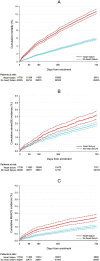Characteristics, treatment, and outcomes of newly diagnosed atrial fibrillation patients with heart failure: GARFIELD-AF
- PMID: 33434417
- PMCID: PMC8006724
- DOI: 10.1002/ehf2.13156
Characteristics, treatment, and outcomes of newly diagnosed atrial fibrillation patients with heart failure: GARFIELD-AF
Abstract
Aims: Heart failure (HF) and atrial fibrillation (AF) may coexist and influence each other. However, characteristics, anticoagulant treatment, and outcomes of contemporary AF patients with concurrent HF are ill-defined. This study analyses characteristics, treatment, and 2 year outcomes in newly diagnosed Global Anticoagulant Registry in the FIELD-Atrial Fibrillation (GARFIELD-AF) patients with vs. without HF.
Methods and results: GARFIELD-AF is the world's largest observational AF patient study. At enrolment, 11 758 of 52 072 patients (22.6%) had HF; 76.3% were New York Heart Association class II-III. Patients with HF had comparable demographics, blood pressure, and heart rate but more likely had permanent (15.6% vs. 11.9%) or persistent AF (18.9% vs. 13.8%), acute coronary syndromes (16.7% vs. 8.9%), vascular disease (40.8% vs. 20.2%), and moderate-to-severe chronic kidney disease (14.6% vs. 9.0%) than those without. Anticoagulant prescription was similar between the two groups. At 2 year follow-up, patients with HF showed a greater risk of all-cause mortality [hazard ratio (HR), 2.06; 95% confidence interval (CI), 1.91-2.21; P < 0.0001], cardiovascular mortality (HR, 2.91; 95% CI, 2.58-3.29; P < 0.0001), acute coronary syndromes (HR, 1.25; 95% CI, 1.02-1.52; P = 0.03), and stroke/systemic embolism (HR, 1.24; 95% CI, 1.07-1.43; P = 0.0044). Major bleeding rate was comparable (adjusted HR, 1.00; 95% CI, 0.84-1.18; P = 0.968). Among patients without HF at baseline, incidence of new HF was low [0.69 (95% CI, 0.63-0.75) per 100 person-years], whereas propensity to develop worsening HF was higher in those with HF [1.62 (95% CI, 1.45-1.80) per 100 person-years].
Conclusions: Patients with AF and HF have a high risk of all-cause and cardiovascular mortality and stroke/systemic embolism and may develop worsening HF.
Keywords: Anticoagulant; Atrial fibrillation; GARFIELD-AF; Heart failure; Stroke.
© 2021 The Authors. ESC Heart Failure published by John Wiley & Sons Ltd on behalf of European Society of Cardiology.
Conflict of interest statement
GA has received personal fees from Merck, Menarini, Angelini, Novartis and Behring; AJ Camm has received institutional grants and personal fees from Bayer, Boehringer Ingelheim, Pfizer/BMS and Daiichi Sankyo. JPB has received personal fee from thrombosis research institute; LGM has received grants and personal fees from Bayer AG during the conduct of the study, and grants from Boehringer Ingelheim, grants and personal fees from Pfizer and personal fees from Daiichi Sankyo and has received support by Italian Ministry of Health Ricerca Corrente ‐ IRCCS MultiMedica outside the submitted work; AKK has received grants and personal fees from Bayer AG and Sanofi; personal fees from Bayer AF, Janssen Pharma, Pfizer, Sanofi, Verseon and Anthos Therapeutics. All other authors have reported that they have no relationships relevant to the contents of this paper to disclose. [Correction added on 25 January 2021, after first online publication: The Conflict of Interest has been updated in this version.]
Figures





References
-
- Hohendanner F, Heinzel FR, Blaschke F, Pieske BM, Haverkamp W, Boldt HL, Parwani AS. Pathophysiological and therapeutic implications in patients with atrial fibrillation and heart failure. Heart Fail Rev 2018; 23: 27–36. - PubMed
-
- Campbell NG, Cantor EJ, Sawhney V, Duncan ER, DeMartini C, Baker V, Diab IG, Dhinoja M, Earley MJ, Sporton S, Davies LC, Schilling RJ. Predictors of new onset atrial fibrillation in patients with heart failure. Int J Cardiol 2014; 175: 328–332. - PubMed
-
- Carson PE, Johnson GR, Dunkman WB, Fletcher RD, Farrell L, Cohn JN. The influence of atrial fibrillation on prognosis in mild to moderate heart failure. The V‐HeFT Studies. The V‐HeFT VA Cooperative Studies Group. Circulation 1993; 87: VI102–VI110. - PubMed
-
- Cheng M, Lu X, Huang J, Zhang J, Zhang S, Gu D. The prognostic significance of atrial fibrillation in heart failure with a preserved and reduced left ventricular function: insights from a meta‐analysis. Eur J Heart Fail 2014; 16: 1317–1322. - PubMed
-
- Crijns HJ, Tjeerdsma G, de Kam PJ, Boomsma F, van Gelder IC, van den Berg MP, van Veldhuisen DJ. Prognostic value of the presence and development of atrial fibrillation in patients with advanced chronic heart failure. Eur Heart J 2000; 21: 1238–1245. - PubMed
Publication types
MeSH terms
Substances
LinkOut - more resources
Full Text Sources
Other Literature Sources
Medical
Research Materials
Miscellaneous

